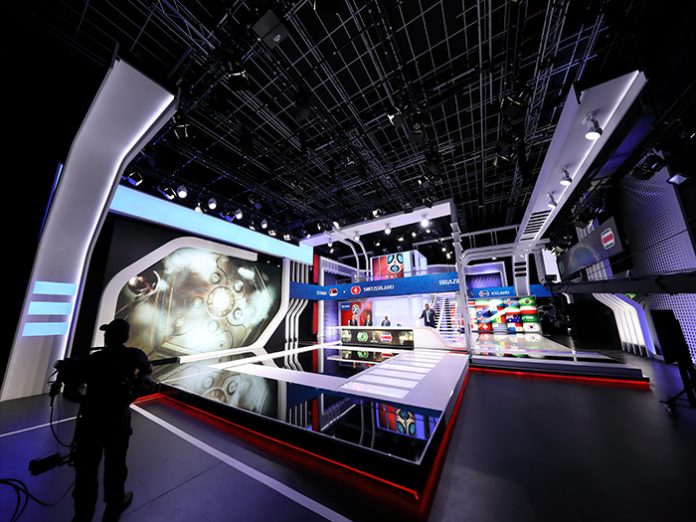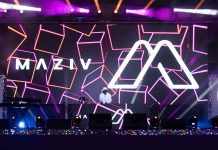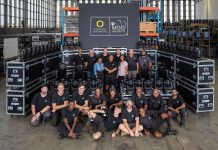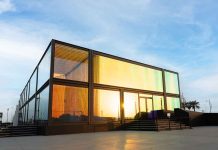In time for the 2018 FIFA World Cup phenomena, SuperSport, provider of televised sports coverage across the African continent, decided to revamp its studio.
Michael Gill of MGD had the vision to completely change the look and feel of the iconic Studio 6. His concept was brought to fruition by Gearhouse SDS who built the set, while DWR Distribution supplied the foundation, a Prolyte Group grid, from which the set and lighting equipment was hung.
Due to several zones in both Studio 6 and the adjacent Arena studio which formed part of the broadcast area, DWR also supplied extra lighting fixtures, a cabling infrastructure, a wireless MA Lighting dot2 remote system and additional dimming.
Jacques Barnard, Vision Control and Lighting Supervisor at SuperSport, said: “We could all see that this was going to be special. Moving away from curves and rounded edges, the new corporate looking set has strong, angular lines with at least ten different zones or presentation areas. The production team loves all the options made available to them. I suspect this design is going to lead the way. It’s very new and something we haven’t seen before.”
To keep the show running during the installation period, Ryan Toerien, Producer/Director and Broadcast Operations Manager at SuperSport, created a make-shift studio in the corporate building across the road at MultiChoice City.
“We ran a fibre line from the control room to the building and basically created a ‘remote production’ and it worked beautifully,” said Barnard. “Ryan had the foresight to utilise the space during the project, and our viewers have become so accustomed to the look that we are considering using it after the World Cup.”
The reveal would coincide with the FIFA World Cup opening ceremony, the football tournament kicking off with the hosts Russia up against Saudi Arabia at the Luzhniki Stadium in the Russian capital.
“However, when we began the process we found that our existing rigging was not up to standard,” said Barnard. “We needed a grid that would be secure and certified. We almost started behind schedule because we realized that we needed to bring on board the services of DWR. Much of the set is suspended from the rig and we had to be 100% sure that everything was according to engineering specifications.”
Lighting Designer Joshua Cutts was commissioned to design the grid and determine the position of the studio’s existing lighting fixtures. “From a trussing perspective, I had to cover as much of the areas as possible with limited resources. I had to make sure that the layout of the grid allowed for future growth and changes to the studio. I worked closely with DWR’s Kevin Stannett, Keith Pugin and Andi Rodgers. I am very pleased with the result as the grid is more stable than it has ever been.”
Duncan Riley, DWR Distribution, said: “DWR Distribution supplied the absolute foundation from which everything hangs, fixtures and set included. We initially wanted to do the infrastructure when SuperSport invested in lighting gear last year, but the timing wasn’t right. This system is a massive upgrade to what was in the studio previously. The trussing infrastructure has to support the weight of certain set elements, one of the main reasons it had to be checked by an engineer.”
Kevin Stannett added: “We dropped all existing trussing; had it powder coated black and re-installed using completely new rigging hardware. With the new and old trussing in black, it magically disappears. We added a new cable structure which included 4 DMX tie lines to the Studio 6 control room as well as DMX outlets on the gird and at floor level.” Additional dimming in studio six includes 5 LSC MDR 10-way DMX splitters. A wireless system enables the studio’s MA Lighting dot2 lighting console to be controlled from a mobile device.”
“We lost quite a few days because of the delay on the set but we understand this industry,” said Riley. “We are used to working under pressure and when you have a deadline, you meet that deadline. SuperSport is a company that delivers on time and being “live” they can’t delay. DWR had to perform to SuperSport’s expectations because if we didn’t, there would be three other companies waiting in line. It’s that simple. Thank you to our team, Kevin, Andi and Keith as well as to Jacob Mogale and the Install Crew.”
Joshua Cutts, who has worked on various projects for SuperSport since 2010, carefully planned the new lighting layout. As SuperSport had upgraded their fixtures from tungsten to LED technology just over a year ago, it was a matter of placing the right lights in the right spots and comprised of QuartzColor Fresnels, Philips Strand SoftLight 300S TV Panels, Robe Robin DL4S Profiles, Robe Robin Spikies, Philips Strand Relayrack panels and control on MA Lighting dot2 consoles.
In addition, DWR supplied a further 5 QuartzColor X5 LED Fresnels, 6 Philips Strand 300S Softlights with barn doors and 20 Longman Excelsior 184 RGBW LED Bars. Additional dimming consisted of 2 Philips Strand Relay Racks (12 way), two DWR Fat Albert Distros and in the Arena studio, an LSC Gen VI (12 way).
“I had to marry what Michael Gill wanted for the set, what the directors wanted for the set and what the cameras needed for the set!” beamed Cutts. “I used a lot of colour on the previous set, but this time around I’m lighting with less colour and relying on the ample LED screens in the revamped studio to add another dimension of colour within the space. Michael and I decided to use a lot of LED white light to match the crisp new design.”
The challenge was being sure not to overlight the space which could result in the set looking flat. As directors tried out the different zones in rehearsal time and played with camera angles, Cutts and his team would follow them and brighten or darken the space to reach a happy medium.
“It’s much like sculpting,” remarked Cutts. “The process is slow because unlike the larger live entertainment shows we do, in a studio everything is visible all the time. It’s almost like theatre in a way where you sit with one look, and you add 5% here, take away 3% there.”
The looks created have been saved, making it easy for the operators to use. “To lock it down we make it simple – one fader per zone and one look per type of show. At the same time, we have to make it energetic, interesting and each shot has to be dynamic.”
There is a renewed energy seen at SuperSport. “The team has a sparkle in their eyes, they want to explore the new spaces and be creative in the newly revamped studio to add value to the production,” concluded Barnard. “Everyone is excited; there’s a buzz, it’s fresh and has ignited us all.”




